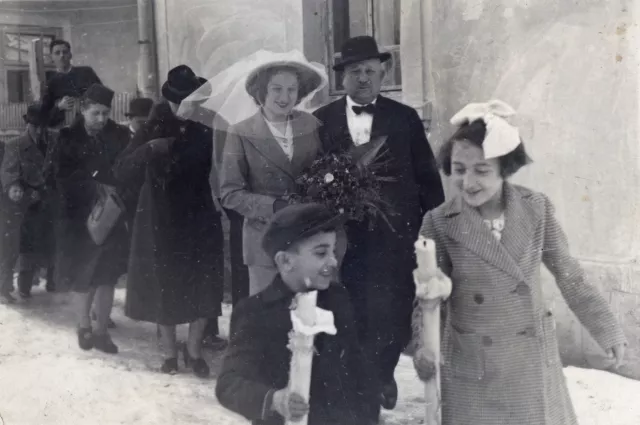This is the wedding of Zafira Pinkas and Yosef Vagenshtain. At the very front you can see me (Victoria Almalekh, nee Levi) and Zaki Vagenshtain with the candles. We were bridesmaids. Behind me you can see the bride Zefira accompanied by her father Yosif Pinkas. The procession is heading for the synagogue. I remember that my child’s coat was brand new. It was bought before we went to Sofia to be evacuated after the 1942 flood in Vidin. There is neither a stamp of a photo studio nor any other inscription.
I remember my cousin Zafira’s wedding. Before marriage comes the engagement. This is a beautiful Bulgarian word –godezh (engagement) which means that the future newly-weds engage each other, before getting married. On the engagement ceremony both sides negotiate when the wedding is going to be, where the young family will live, what the dowry that the bride will be, which side will give what, etc. This practically means laying the economical foundations of the new family. Let’s go back to my cousin’s wedding. First the groom had to go and officially take the bride from her house, but that was only a mockery. Her father would take her out and the groom was accompanied by his parents. So they headed to the synagogue, lead by the brides men, carrying the wedding candles. You can see them on the picture. Once they reached the synagogue they would go to the tevah. Two people chosen from the family are present by the tevah. In modern weddings they are called best men. They were present at the vows exchange. When the rabbi announced and blessed the marriage those two people were holding the two ends of a tallit and they threw it over the newly-weds. It was the symbol that came to show that the marriage was a fact. Wedding rings were then exchanged. Then a chorus or a duet (depends on what the synagogue had) sang the Mendelssohn march and the sexton who’s behind the tevah – would break a glass for good luck and say ‘Let this be a good sign’ in Ivrit. That was the sign that the marriage was a fact. In those days there were no more ketubbahs – wedding contracts. (The wedding took place around 1940.) However, mum had a ketubbah. She got married in the same synagogue.
At the entrance (this beautiful entrance that I already told about) there were some girls waiting with trays full of marzipan, and, first of all, when the bride walked through the synagogue doorstep a bowl of candy and rice was spilled. It was a symbol of the wish their happiness to be as multiple as the rice seeds and as sweet as candy. And then these two girls gave treats of marzipan to the guests and the ones who brought flowers could present them. 1940 was quite a difficult year and on top of that no one would go to a restaurant in wintertime. Wedding lunch usually would be held at the groom’s mother’s house. So that was the custom – engagement should be held in the bride’s home, and lunch, dinner or whatever they’ve decided to give – at the groom’s mother’s home. In some cases there was no honeymoon, because things were quite mixed-up economically and politically.



















